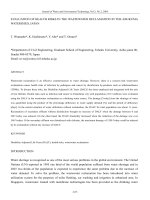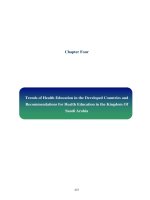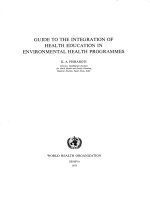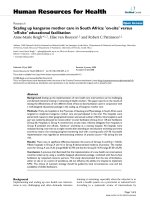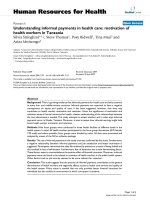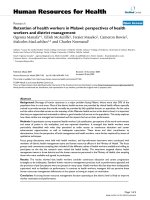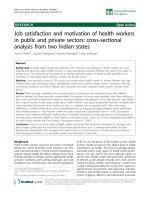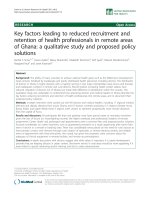Estimating cost of implementing kangaroo mother care (KMC) at different levels of health system in addis ababa
Bạn đang xem bản rút gọn của tài liệu. Xem và tải ngay bản đầy đủ của tài liệu tại đây (440.21 KB, 89 trang )
Addis Ababa University
College of health sciences
School of public health
Estimating Cost of Implementing Kangaroo Mother Care (KMC) at Different levels of Health
System in Addis Ababa
By: Dagmawit Tesfaye (Bsc.)
A Thesis Submitted to the School of Graduate Studies of Addis Ababa University as Partial
Fulfillment of the Requirements for the Degree of Masters of Public Health.
Advisors: Professor Damen Haile Mariam
Birhan Tassew (MPH)
June, 2017
Addis Ababa, Ethiopia
APPROVED BY THE BOARD OF EXAMINERS
This thesis, by Dagmawit Tesfaye is accepted in its present form by the board of examiners as
fulfilling for the degree of master’s in public health.
Advisor
_________________________ ________________ ___________ __________
Full name
Rank
Signature
Date
External Examiner
_________________________ _________________ ___________ ___________
Full name
Rank
Signature
Date
Internal Examiner
_________________________ _________________ ___________ __________
Full name
Rank
Signature
Date
Chairman, Department Graduate committee
_________________________ _________________ ___________ __________
Full name
Rank
Signature
ii
Date
Acknowledgment
First and for most I would like to thank God, my unseen partner, for helping me through all my
thesis work. Second I would like to express my deep appreciation to my advisors Professor
Damen Haile Mariam and Birhan Tassew (MPH) for their constructive comments and
unreserved support. I am also thankful for School of Public Health of Addis Ababa University
for providing the opportunity and references. Furthermore I would like to express my gratitude
for TiruneshBejing General Hospital and Akaki Health Center facility officials for their positive
outlook on this study and providing information. Last but not list I would like to thank my
friends and family for the help they kindly and lovingly provided.
iii
Table of contents
Acknowledgment ........................................................................................................................... iii
ACRONYMS ................................................................................................................................ vii
1. INTRODUCTION ...................................................................................................................... 1
1.1 Background ........................................................................................................................... 1
1.2 Statement of the problem ...................................................................................................... 2
1.3 Significance of the study ....................................................................................................... 3
2. LITERATURE REVIEW ........................................................................................................... 4
2.1 Method of costing and costing approaches in health care ..................................................... 4
2.2 Economic evaluations on kangaroo mother care................................................................... 5
3. OBJECTIVE ............................................................................................................................. 12
General Objective ...................................................................................................................... 12
Specific Objectives .................................................................................................................... 12
4. METHODOLOGY ................................................................................................................... 13
4.1 Study Area ........................................................................................................................... 13
4.2 Study Design ....................................................................................................................... 13
4.3 Source population................................................................................................................ 13
4.4 Study Population ................................................................................................................. 14
4.5 Sampling Procedure ............................................................................................................ 14
4.6 Data Collection.................................................................................................................... 14
4.7 Study Variable ..................................................................................................................... 15
4.8 Method of Cost Estimation ................................................................................................. 16
4.8.1 Description of the program ........................................................................................... 16
4.8.2. Perspective of analysis................................................................................................. 17
4.8.3. Estimation method ....................................................................................................... 17
4.9 Data Analysis Procedure ..................................................................................................... 21
4.10 Sensitivity analysis ............................................................................................................ 22
4.13 Operational definition ....................................................................................................... 24
5. RESULTS ................................................................................................................................. 25
5.1 Characteristics of health facilities ..................................................................................................... 25
5.2 Total Cost, Average Cost and Utilization in Tirunesh Beijing General Hospital ............................. 26
5.3 Total cost of KMC service at Akaki Health Center .......................................................................... 30
iv
5.3 Pre-facility and post facility cost of Kangaroo mother care ............................................................. 32
5.4 Sensitivity analysis............................................................................................................................ 33
6. DISCUSSION ......................................................................................................................................... 36
7. CONCLUSION ....................................................................................................................................... 38
8. STRENGTH and LIMITATIONS .......................................................................................................... 39
9. RECOMMENDATIONS ........................................................................................................................ 40
10. REFERENCE........................................................................................................................................ 41
Annex 2 ....................................................................................................................................................... 53
v
List of Tables and Figures
Table 1: Parameter uncertainties, alternative assumptions, and sensitivity analyses on service
providing of Kangaroo mother care in TiruneshBejing General Hospital,Akaki Health Center and
urban health extension program in 2017 G.C…………………………………………..17
Table 2: Cost for effectively providing mother infant dyad of kangaroo mother care service at
Tirunesh Bejing General Hospital (TGBH) by cost category in the year 2017…….21
Table 3: Total cost of kangaroo mother care service at TiruneshBejing General Hospital (TGBH)
by cost category in the year 2017……………………………………….22
Table 4: Total cost of kangaroo mother care in Akaki Health Center by cost category in
2009…………………………………………………………………………………………23
Table 5: Total cost for follow up visits of urban health extension program under Akaki Health
Center in 2017…………………………………………………………………24
Table 6: Results of alternative assumption by Sensitivity analysis on costing of Kangaroo Mother
Care in 2017G.C………………………………………………………………………………27
Fig 1: Kangaroo mother care service activities and associated cost items in 2017
G.C………………20
vi
ACRONYMS
CEA
Cost Effectiveness Analysis
CMC
Conventional Method of Care
HDAL
Health Development Army Leaders
HEW
Health Extension Worker
KMC
Kangaroo Mother Care
KWC
Kangaroo Ward Care
LBW
Low Birth Weight
TBGH
Tirunesh Beijing General Hospital
USD
United States Dollars
VLBW
Very Low Birth Weight
WHO
World Health Organization
vii
ABSTRACT
Background: Globally it is estimated that 15 million babies are born preterm. Ethiopian neonatal
mortality rate in 2015 was 28 per 1000 live births. Kangaroo mother care(KMC) has been
proposed one safe and effective solution for preterm and low birth weight infants and can
provide a very good alternative for neonatal intensive care unit. This study was conducted to
estimate the cost of providing KMC to mother infant dyad and outline the major resource inputs
incurred by the health system.
Objective: To estimate the cost of providing kangaroo mother care (KMC) at different levels of
health system in Addis Ababa 2017 G.C
Methodology: Facility based cross sectional study design was used to collect cost data and
utilization data from facility perspective. Purposive sampling was used to select the facilities
providing kangaroo mother care. This study employed accounting method of cost estimation in
order to estimate the total cost of implementing kangaroo mother care. The total cost was
estimated by summing up the direct cost, indirect cost and intermediate cost.
Result: The average cost providing KMC for mother infant dyad at Tirunesh Beijing General
Hospital is estimated to be USD 55.3. The total cost of providing KMC at the TBGH for a total
of one month, was estimated to be USD 874.86. The total cost for providing KMC at the Akaki
Health Center is estimated to be USD 654.31. Thus unit cost for a follow up for one mother is
about USD 65.28.The total cost for providing the KMC post facility follow up, i.e. four visits till
the neonate is 28 days post-delivery, is USD 809.71.
Conclusion and recommendation: The total cost for providing kangaroo mother care at
Tirunesh Beijing General Hospital and Akaki Health Center was found to be USD 874.86 and
viii
USD 535.24 respectively. Health professional salary at both the TBGH and Akaki Health center
has the highest cost for total cost. Further studies on assessing the health outcome and health
impact of KMC by doing further research will help in knowing the return of the money spent.
ix
1. INTRODUCTION
1.1 Background
Under-five children mortality globally in 2015 was 42.5 per 1000 live births, out of these deaths
45% were recorded as new born with a neonatal mortality rate of 19 per 1000 live births. From
the enlisted causes for the deaths the major one was attributed to prematurity [1]. Preterm
delivery is one of the causes for neonatal mortality. Globally it is estimated that 15 million
babies are born preterm. Sixty percent of the preterm births occur in Africa and South Asia. Each
year one million babies die due to premature birth complication like hypothermia and
hypoglycemia and other preterm related problems [2]. Progress has been made to reduce
mortality in under-five children but improvement in the neonatal period is less [3].Ethiopian
neonatal mortality rate in 2015 was 28 per 1000 live births [4].
Though there is not just one simple solution for the reduction of neonatal mortality, kangaroo
mother care (KMC) has been proposed oneof the safe and effective solution for preterm and low
birth weight infants and can provide a very good alternative for incubation care [5].Especially in
developing countries where incubation care is not sufficient, KMC has been well appreciated.
Kangaroo mother care is defined as having four components: early, continuous and prolonged
skin to skin contact between preterm baby and the mother, exclusive breast feeding, early
discharge after hospitals initiated KMC with continuation at home and close follow up at home
[6].Kangaroo mother care was found to improve neonatal outcomes and reduce neonatal
morbidity and mortality by preventing hypothermia, and by keeping other vital signs stable
through skin to skin contact and providing benefits of breast feeding [7, 8].
1
Ethiopia has different health care system level and has managed to achieve a remarkable increase
in access to primary health care units [9]. The country can benefit from the implementation of
KMC as conventional care is inconvenient in majority of the health centers due to largely
financial constraints. If the KMC is to be implemented effectively its influencing factors need to
be clearly delineated. One of the influencing factors that pose a question is the cost of providing
KMC effectively in the different levels of the health care establishments.
Estimating the cost of a certain intervention can serve as an important tool. Assessment of the
cost of providing such intervention will help the policy makers in decision making and help as
one input for further scale up of an intervention.
This study was conducted to estimate the cost of providing KMC to mother infant dyad and
outline the major resource inputs incurred by the health system.
1.2 Statement of the problem
Ever since Kangaroo Mother Care (KMC) was proposed by Dr. Edgar Ray Sanabria, a
Colombian pediatrician, in 1978 the KMC has drawn the interest of many scientists and
researchers. Many researchers tried to show the method is at least as good as the incubation care
[10].
Researches done in Ethiopia as well as other countries have shown that KMC is effective,
acceptable and cheaper than the conventional care in the randomized control trials [11]. Also
researches on effectiveness of KMC in the Tikur Anbessa Specialized Hospital have shown
frequent follow up for at least two months is very important [12].
2
Different nations need further evidence that can explain the programs benefit in addition to the
scientific merits. Avoiding the emergence of programs of suboptimal quality due to costcontainment requirements is among the challenges that face the KMC program [10]. As it is
stated in the guideline for implementing the KMC the first step to a national program of the
KMC is situational analysis which includes that there must be a relevant data sheet regarding the
cost of providing the care [5]. Studies also put forward that when a nation applies the program it
needs pertinent data on how much is being spent on the different health care levels and act
accordingly. They have also recommended that thorough investigation on the health economics
will help the program [10].
Since there was no this study done in Ethiopia to calculate the cost of implementing kangaroo
mother care in different health care setting, estimation of the costs with regard to its facility
context will help in further scale up and efficient allocation of health care resources.
1.3 Significance of the study
This study could help as a basis for further scale up of KMC program which in turn will help our
country to reduce neonatal mortality. Estimating the cost that is being incurred by implementing
KMC program is important source of data to the policy makers that are going to allocate budget
for the health program in general. Not only estimating the cost at one health facility but in a more
or less inclusive manner to the different health care tiers will help get the comprehensive picture.
3
2. LITERATURE REVIEW
2.1 Method of costing and costing approaches in health care
The two methods of cost analysis are accounting method and statistical method. Accounting
method makes use of accounting information and reanalysis of hospital service records to
calculate hospital costs. This can be useful for a single hospital and contains labor intensive
detailed examination of hospital accounts, staffing patterns and admissions. Statistical method
uses observations of costs and services of many hospitals. This helps in knowing the relations
between marginal cost and average cost. This method needs large number of detailed and well
documented observations [13].
Total cost of a particular service can be determined by quantity of resources consumed and unit
cost of the resource items. Five steps are taken for costing methods. These are portraying the
decision problem and establish objectives of costing (Selection of study perspective, time
horizon and explicit statement about the assumptions applied are also an essential part of this
step), followed by describing the service in detail (final cost object), then identifying and
classifying of resource items and units of resources utilized to deliver a particular service. The
units of measurement (units of input) can be an activity or physical resources such as disposables
or drugs. The next step is measuring resource consumption in natural units; and placing
monetary value on these resource items (goods, activities, and/or services) and calculating the
unit costs of a particular service [14].
Two approaches can be applied in costing methodology. A top-down approach is useful for those
cases where marketed health technologies (pharmaceuticals, medical devices and other
consumables) are responsible for most of the resource use. However, in those cases where
4
service provision is based on complex organizational arrangement (input mix could vary
significantly), and human resource costs and overheads are responsible for a large portion of the
total costs, the inaccuracies introduced by a top-down approach become important, and a bottomup approach is to be preferred [14].
The bottom-up approach records resource utilization at the patient or individual service level,
and aggregates patient/service level utilization data to identify the type of resources used and to
measure resource utilization in order to calculate the costs of specific services. This method can
be deployed retrospectively and prospectively using medical records, surveys, questionnaires or
other reliable databases. It is also called micro-costing or activity based costing [14].
2.2 Economic evaluations on kangaroo mother care
The KMC program is a care system with three basic components; position nutrition discharge
and follow-up.Many research papers have been written to evaluate its effectiveness in preventing
the premature neonatal deaths and improving the lives of stable but premature infants. Also
literature that base their studies on the hospital setting have addressed the issue of economic
impact of the program using cost effectiveness analysis techniques.
A review article on Kangaroo Mother Care to look back on a25 year run of the program has
shown the use and adaptation of KMC to different settings in three main scenarios:(1) settings
with a very low level of development and severely restricted access to any level of neonatal care;
(2) settings with access to appropriate resources but which are insufficient for the number of
premature births; and (3) settings with little or no restriction on access to high-technology
neonatal care. Though KMC in developing countries with limited health resources originated
mainly in response to these circumstances, the benefits attributable to it far exceed its effects on
5
overcrowding in busy, understaffed, and underequipped neonatal units. One of the most
immediate effects of KMC is to prevent prolonged separation of the mother and her low birth
weight infant, which contributes to morbidity, insufficient milk volume, poor growth, and poor
mother-to-infant bonding [10].
Essential costs, costs to be carried by the normal budget, additional fund-raising needs were
sought-after, before implementing the program. The question on How will the KMC programme
be financed is one of the questions assed in the designing of the program. Impact of a new
intervention on an institution as a totality needs to be assessed by considering capital
expenditure, space (ward, outside recreational area), heating, staff expenses, lodging for mothers
doing intermittent KMC, equipment, furniture (chairs, beds, tables), refrigeration, household
items (needed for continuous KMC), KMC wrappers, special bedding (e.g. attractive
bedspreads), curtains household equipment (e.g. crockery and cutlery, kettle, washing, machine,
microwave oven), recreational equipment and material (e.g. TV, reading material) [15].
Study done in the three countries, India, Indonesia and Philippines, shows the three ways in
implementation of facility-based kangaroo mother care. Three major themes were identified:
pioneers of facility-based KMC; patterns of KMC knowledge and skills dissemination; and
uptake and expansion of KMC services in relation to global trends and national policies pioneers
of facility-based KMC were introduced later on. Training method beneficial to the initial
establishmentof KMC services in a country was to send institutional health-professional teams to
learn abroad, notably in Colombia.Furtherin-country cascading took place afterwards and still
later on KMC was integrated into newborn and obstetriccare programs.The patchy uptake and
expansion of KMC services took place in three phases aligned with global trends of the time:the
6
pioneer phase with individual champions while the global focus was on child survival, the
newborn-care phase and lastly the current phase where small babies are also included in action
plans [16].
A study conducted on thirty-six hospitals in the Provinces of Gauteng and Mpumalanga in South
Africa which were targeted to implement kangaroo mother care illustrated that the
implementation of a new health care intervention could be scaled up by using a carefully
designed educational package, combined with face-to-face facilitation by respected resource
persons. This study demonstrated that the site of facilitation, either on site or at a centre of
excellence, did not influence the ability of a hospital to implement KMC. The choice of outreach
strategy should be guided by local circumstances, cost and the availability of skilled facilitators
[17].
Kahatun review on KMC as a simple method of care for developing countries states that KMC is
a cost-effective alternative to incubator care for LBW newborns in low-resource
settings.itdemonstrate the feasibility, acceptability, and effectiveness of KMC in rural areas. The
burden on health systems imposed by care ofpreterm infants in high-income countries is
considerable and well recognized. Indeed it is estimated that the cost of care for a single preterm
birth in the USA is US$ 51600 [18].
According to a study conducted on a referral hospital in Nicaragua the average cost of all drugs
forneonatal care before implementation of KMC was US$ 4.97 but afterKMC program it was
US$ 3.65. The differencewas due to primarily lower costfor infant formula and medications inthe
post-KMC period. In the same study conducted for the Nicaragua hospital the total average cost
7
for care for a neonate was US$ 2,322 in the pre-KMC period and US$ 1,808 in the KMC period.
The largest part of these costs was attributed to training health professionals. The combined cost,
considered a single, fixed expense, was just over US$ 23,000. The additional per patient cost
included consumables given to the parents of each neonate. In addition this study showed that
analysis of the costs comparingthe KMC to no KMC showed that theamount of money saved on
in-patienttreatment of high-risk neonates in theKMC program would offset the costof initial
training and implementationof health workers and changes to thehospital system after treatment
of 45premature neonates or 1–2 months of deliveries.After 12 months, implementingKMC in this
referral hospital is projected to save more than US$ 233,000. This study also shows that in its
point estimates for the difference in cost between the KMC and no KMC strategies show that
even with the conservative estimate, implementing KMC is expected to begin to save money
after fewer than 275 neonates are treated, or less than five months after full implementation.
After 12 months of implementation, KMC is estimated to save more than US$ 233,000 using the
referral hospital incubator use data or around US$ 166,000 with the more conservative incubator
use estimate. However, these results are point estimates not taking into account the confidence
intervals of data obtained from samples.
Using the uncertainty in the model inputs, the
acceptability curves show the probability of KMC implementation in the 12 hospitals being costsaving over time. Even under conservative assumptions, using KMC is projected with almost
100% certainty to produce savings after one year of implementation [19].
Another study conducted using secondary analysis to compare cost effectiveness of
‘KangarooWard Care’ with ‘Intermediate intensivecare’ in stable very low birth weight infants,
less than 1100 grams using a randomizedcontrol trial in the tertiary care nursery of
theDepartment of Neonatology, Fernandez hospital, Hyderabadfrom November 2013 to August
8
2015, using 141 infants (less than 1100g and ≤ 32 weeks at birth) as control, there was
significant reduction in neonatal charges in KWC group, after the samples were divided to two
unequal groups where one group was put in the intermediate intensive care and the rest in the
KWC. The separate“top-down” and “bottom-up” cost analysis showed that there was significant
reduction of hospital and parentsexpenditure in KWC group when compared to intermediate
intensive care (IIC) group (p < 0.001). There was significant saving of around 33,800INR (USD)
in the KWC group for each patient [20].
An additional study conducted on low birth weight neonates in Tabriz 2010‑2011 to analyze cost
and effectiveness analysis of kangaroo mother care and conventional care method, the mean cost
of hospitalization per individual infant for KMC was $3539.47, whereas for Conventional group
was $2907.27 and also showed that KMCpromoted weight gain in LBW infants better than
conventional care. Hence their study concluded that, although KMC’s unit cost is a little higher
than Conventional method, it can be considered as cost effective method. The reason for this was
the positive outcomes on breastfeeding’s and mortality that was attained by the KMC [21].
An economic evaluation study conducted by a regional Health Innovation and Education Cluster
in the United Kingdom upon 18 neonatal units has shown that for every £1 invested in the
intervention to increase kangaroo skin-to-skin care and breastfeeding rates, between £4.00 and
£13.82 of benefit was generated. The aim of the study was to increase KMC skin-to-skin care
and breast feeding rates by generating an economic outcome data that can be compared with the
cost of the interventions [22].
A randomized controlled trial was carried out in Addis Ababa, Yogyakarta and Merida to study
the effectiveness of KMC. The aim of the study was to show the effectiveness, feasibility,
acceptability and cost of kangaroo mother care in comparison to conventional methods of care.
9
The study set out to see the managerial, financial and cultural aspects on these different settings.
The randomized control trial in Addis Ababa showed that outbreak of infection occurred four
times in the conventional method of care (CMC) ward and only once in the KMC ward. The four
bedroom set up in KMC ward was comfortable and sufficient for the mothers while in the CMC
ward there was over crowding 60% of the time. Cost comparisons were stated jointly for the
three study areas. Running cost for KMC was 50% less than that of the CMC US$ 11,788 versus
US$ 29,888 for salaries, and US$ 7,501 versus US$ 9,876 for other items. A higher cost for other
items in CMC was attributed to cost of keeping the ward at 320c in Addis Ababa. Items like food
for mothers and laundry made KMC more expensive than the CMC care [11].
A cost effectiveness analysis done in an Ethiopian setting for interventions that are provided
during pregnancy, childbirth and neonatal period have shown that interventions delivered in
packages were more cost effective than those delivered in single unit. The study used the World
Health Organization’s Choosing Interventions that are Cost Effective (WHO-CHOICE) maternal
and neonatal health model on thirteen interventions for mothers and neonates. The
incrementalcost and effectiveness of an intervention scale up with the do nothing scenario all
interventions except calcium supplementation were very cost-effective with ICERs less than one
time GDP per capita. One of the interventions that was claimed to be cost effective was KMC.
Calcium supplementation was not cost-effective for a threshold of three times GDP per capita in
Ethiopia.The cost effectiveness analysis done showed that the scale up and source use of KMC
use was 1% [23].
A cross sectional descriptive study conducted at Tikur Anbessa Specialized Hospital from July
2009 to May 2010 on 110 very low birth weight neonates who came to the hospital at least once
10
has shown that the continuation of KMC after discharge was associated with reduced mortality
(6.5% vs. 23.5%, P = 0.046) [12].
The studies conducted outside of Ethiopia so far have shown that conducting an economic
evaluation and cost estimation can help an intervention program. The studies done inEthiopia
have also addressed the benefits of KMC by comparing it with the conventional care in addition
to the cost of the KMC care compared to the conventional care. The studies in totality have
confined their research on the KMC program that is established at the hospital level using
comparative study. This research thesis on the other hand, has evaluated the cost for providing
KMC for mother infant dyad at different health systems of Addis Ababa without comparing it to
the conventional care. By doing so it tried to bridge the lack of sufficient data that is seen when it
comes to cost of care data of the KMC interventions.
11
3. OBJECTIVE
General Objective
To estimate the cost of providing kangaroo mother care (KMC) at different levels
of health system in Addis Ababa 2017 G.C
Specific Objectives
To calculate the cost of implementing kangaroo mother care (KMC) at Tirunesh
Beijing General Hospital
To estimate the cost of implementing kangaroo mother care at Akaki Health
Center
To calculate the cost of follow up of kangaroo mother care (KMC) at urban health
extension program
12
4. METHODOLOGY
4.1 Study Area
Addis Ababa is the capital city of Ethiopia. The city is divided in to ten sub-cities which are the
second administrative units next to city administration. In terms of area coverage Bole is
thelargest sub-city followed by Akaki-Kality and Yeka. Addis ketema is the smallest and
followed by Lideta and Arada Sub-cities [22].
The health infrastructure of the city comprises three health system levels. These are specialized
teaching hospital, general hospital and primary hospital (health centers and urban health
extension programs). There are 11 hospitals of which five hospitals are under the Addis Ababa
health bureau and the other five are under the federal ministry of health and the remaining one
hospital is under Addis Ababa University. There are also 111 currently functioning health centers
in the city. The study area Akaki Kality sub-city in 2004 E.C had total population of 201,701
with male to female ratio .96:1 [22].
4.2 Study Design
Cross sectional study design was used to assess the cost of implementing kangaroo mother care
from the health service provider perspective.
4.3 Source population
The source population for this study are all governmental health facilities in Addis Ababa who
are going to implement the KMC in the scale-up program.
13
4.4 Study Population
The study populations were Tirunesh Beijing General Hospital (TBGH), Akaki Health Center
and urban health extension program under Akaki Health Center were all KMC components is
being implemented in pre-facility, facility and post-facility phase.
4.5 Sampling Procedure
During the study period the pre-facility, facility and post-facility KMC program was only being
under taken in the Tirunesh Beijing General Hospital, Akaki Health Center and urban health
extension program under Akaki Health Center. Hence the procedure of sampling was a nonprobability sampling procedure where purposive sampling was used to attain the objective stated.
4.6 Data Collection
Cost information of different inputs and resources used to provide KMC service were collected
from March 2017 to April 2017. The fixed and variable cost inputs at the health facilities were
listed, valued and cross checked after the specific activities carried out on pre-facility, facility
and post-facility implementation of KMC service were listed out.
The WHO standard costing and financing tool was used as a guide and was customized to fit the
study being conducted. The questioner had four sections: facility information section, direct cost,
indirect cost and intermediate cost.Direct cost included sections for staff (health professional)
where type of profession, number of professional, salaries and benefits were collected.
Equipment (furniture, weighing scale, thermometer and other consumables) were listed out with
the unit price and quantities selected. The use of drugs and laboratory investigations were
14
obtained from the medical record of the babies as the quantity and type depends on the baby’s
condition. Indirect-cost included sections for overhead cost including, building, furniture and
other capital materials, supportive personnel, and other running cost (utility, stationary
items).Intermediate cost section included were laundry, catering and cleaning.
The data were collected by interviewing of different department heads using the checklist
(human resource head, finance head, procurement officers, medical directors, communication
officers, maintenance officers) in both health facilities. Document review, physical measuring of
rooms and counting of equipment were done. Purchase price of items which were available from
the facility was taken and for items with no available purchase price (donated items) market
price was taken. Proportion of staff time spent on the providing the KMC service was gathered
from staff interview using the checklist. The utilization data of KMC service were collected
through document review and staff interview. All cost were converted to US dollar by using the
average exchange rate in 2017 (USD=ETB 23.0795) to enhance the comparability between
studies [23].
Two data collectors carried out the interview, document review, measuring of rooms and
equipment counting guided by the principal investigator. The data collectors were provided with
a one day-training which included explanation about the study design, costing theory and
concepts, interview methods and techniques and the data collection instruments used. They were
also informed about the type and sources of secondary data needed to be collected for the study.
4.7 Study Variable
Outcome variable
•
The total cost and unit cost of implementing the KMC service.
15
Explanatory variable
•
Levels of health facility
•
Type of health professionals
•
Catchment population
4.8 Method of Cost Estimation
4.8.1 Description of the program
The new program of implementing KMC at pre-facility, facility and post-facility allows babies
delivered at home or at the facility to be weighed and to be enrolled in the KMC if found to be
VLBW or preterm. In the pre-facility phase of the program, health development army leaders
(HDALs) are given health promotion about deliveries occurring around their area should be
referred to the nearest facilities to be weighed and for other services. They will also train on the
meaning and benefits of KMC. Trainings are also given to the health professionals and health
extension workers. Health professionals are trained on how to counsel and demonstrate KMC to
mothers, weighing babies after delivery and further follow up of the baby in the facility. Health
extension workers are trained on how to follow up on baby’s condition and mothers practice of
KMC. Babies who are born at the facilities will be weighed and identified for initiation of
KMC.Babies which are found to be very low birth weight (VLBW) and preterm will be enrolled
to the KMC program after stabilization of the baby’s condition is achieved. Enrolling the mother
in the KMC program includes counseling the mother about the benefits and components of
KMC, in addition to demonstrating the position of KMC to the mother. After discharge criteria
are met, the KMC is allowed to continue at home with close follow up of the practice at home.
At the post facility phase of implementing the program, the fourth component of KMC (close
16
